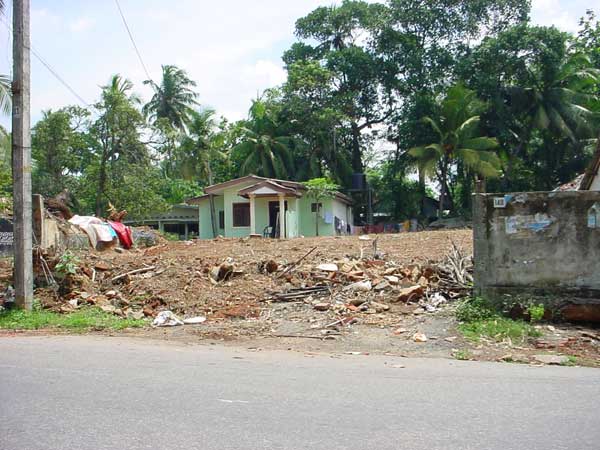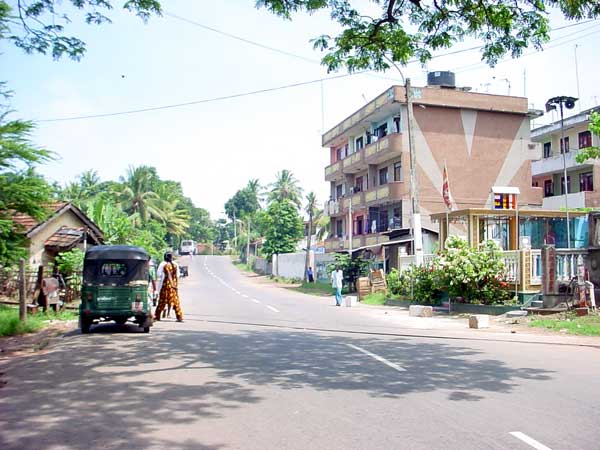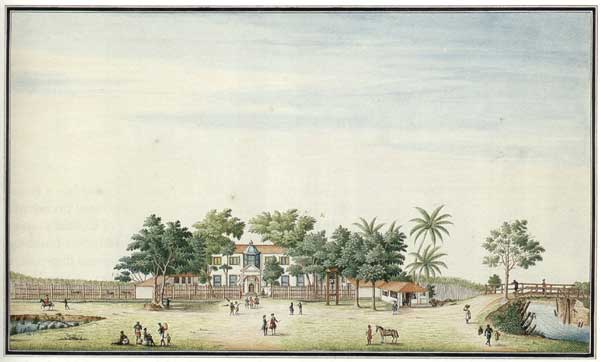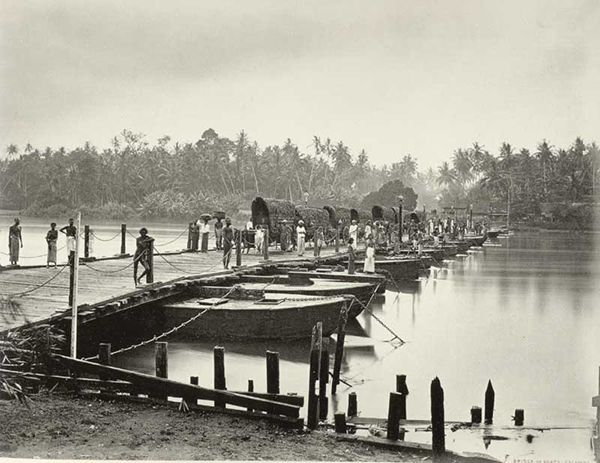Mahawatta, in the Grandpass area of Colombo, is a property steeped in history. It has been identified with the D’andrado families for well over 200 years. In this page we trace the Dutch grant of this land in 1785, the subsequent allotments of this land in1877, and the situation as at to date.
The property is situated on either side of Mahawatte Road, in Madampitiya (now called Janaka Mallamarachi Road). This road turns off from near the Zainstan Cinema, on Sirimavo Bandaranayake Mawatha, the main approach road to the Victoria Bridge. During the Dutch period this area was called Nakalagam, and the main Road too was called Nakalagam Road. Nakalagam Road exists today, as indicated in the street map reproduced below. Parts of the property have been acquired by the Government from time to time, and compensation for these at times have been claimed by total outsiders. One of these acquisitions has been to build the approach road to the Victoria Bridge, now replaced by the modern Japan-Lanka Friendship Bridge.
 |
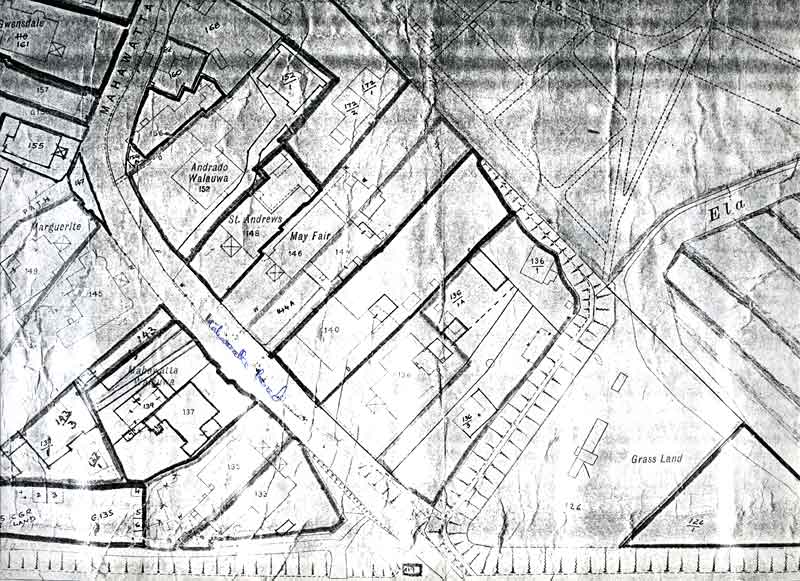 |
| The Mahawatta property superimposed on a current day street map. | Street Plan of part of the Mahawatte Property, showing the ‘Andrado’ and ‘Mahawatte’ Wallauwas. |
Mahawatta in the early years was mostly marshy land and was used for paddy cultivation. Canals crossed the property to drain away the water. Years later a Bund was built as part of the Kelani River Flood Prevention Scheme. As indicated in the street plan reproduced below, this ended abruptly behind the house of Dr. Patrick John de Fonseka (140), as he objected to his land being taken for the construction, without a deed or proper documentation.
During Portuguese times there were two points at which ferries were established to give access to the North as well as the interior of the country. Both lay in close proximity to Mahawatta. One was at Nakalagam, which the Portuguese called the ‘Passo Grande’ (which later became Grandpass), and the other was downriver and was called ‘Pasbetel’ or the ‘Pass of the Boats’. In 1822 this was replaced by a pontoon, which came to be called the ‘Bridge of Boats’. It was not until 1865 that the railway bridge was built, and 30 years later in 1895 the ‘Victoria Bridge’ was completed. Interestingly it was only in 1904 that the first motor vehicle was imported to Ceylon. By 1905 the country boasted 21 motor cars, with Mr. E. L. F. de Soyza and N. D. B. Silva being the only Ceylonese. During Dutch times, Nagalagam Street in Grandpass was also the home to the Country House of the Dutch Governor. An early print of this beautiful property has been reproduced below.
Today Mahawatta is a bustling commercial area, with a mix of residential housing. Most of the low-lying land has been reclaimed. A brand new road on its southern border known, as the Port Access Road is the entry and exit point for the majority of the country’s trade with the outside world. The road also gave access to parts of low lying family land not accessible previously, and today, total outsiders have been compensated for or encroached upon these lands.
Out of the original clan that lived at Mahawatte, only a few de Fonseka and D’andrado families remain. The only de Fonseka living there now is Mrs. Jean de Fonseka, widow of Dr. Patrick John de Fonseka at 140 Mahawatte Road. The adjoining properties of 144 & 144A is owned by Dr. Srilal Fernando of the same family. The Andrado Walauwwa and two other properties on either side was owned by Dennis D’andrado until his recent death. The de Silva Wijeratne families too have long since vacated the area. It is said that at one time the toll at the ‘Bridge of Boats’ was collected (rented) by the de Silva Wijeratne family. The D’andrado and de Silva Wijeratne families have been the most prominent families in this part of Colombo.
Going back in history, the property is first mentioned in the book “The Chieftains of Ceylon” by J. C. Van Sanden . Under the heading titled “Some Prominent Chief Headmen of the Past”, it gives the following description of Reynoldus D’andrado:
D’ANDRADO Reynoldus:
Mudaliyar and Military officer, under the Dutch from whom he received a grant of 58 acres of land known as ‘Mahawatte’ in Grandpass, Colombo, which is still in the possession of his descendants.
Another interesting reference is made to this property in the Times of Ceylon of February 4th, 1954. In the letters to the Editor column, P. R. Sittampalam writes a letter about Don Manuel D’Andrado. (This was subsequent to a letter he wrote to the Ceylon Observer a few years earlier, which drew a barrage of protests including a letter from Gustavus Jayewardene of Moratuwa, dated February 6th 1940, which has been reproduced in the ‘Karava’ Pages of this site). In this later article he praises Don Manuel D’andrado’s exploits in Jaffna, and describes ‘Mahawatte’ in the closing paragraphs of the article.
“D’andrado returned to Colombo a year later and it appears that in appreciation of his service in connection with the discovery and destruction of the plot, he was gifted by the Dutch with 64 acres of land at Mahawatte, Grandpass, where he built “Andrado Walauwa” and used it as his principal residence in Colombo.”
However there is no base to this, as all available evidence points to ‘Mahawatte’ being a Dutch grant given to Reynoldus D’andrado.
In ‘The Varnakula Addittiya Arasanilayitta Clan“, an article by F. B. De S. A. Jagath Wijayanayaka (Berty) which was published in the ‘Kurukshetra’ Journal Vol 2 of 1976 (the Journal of the Kshatriya Maha Sabha, Sri Lanka), he defines the relationship between Don Manuel and Reynaldus and also refers to the “Mahawatta” property.
RENALDUS D’ANDERADO, Mudaliyar
Son of Don Manuel and grand son of Don Manuel Mohandiram of Colombo, and great grand son of Don Louis D’Anderado Adigar. Renaldus D’Anderado ‘s father Don Manuel does not seem to have held office and appears to have left Calutara and settled down in Colombo in 1721. In the Acts of Appointment dated 1787 and 1790 granted to Renaldus reference is made to Don Louis and Don Manuel. Renaldus received a grant of 58 acres in Grandpass, Colombo, now known as Mahawatte most of which still belongs to members of the De Fonseka and D’Andrado families (Plan of Partition dated 25th April 1877 preserved with the De Fonseka Family).
Note: The Partition Plan referred above has been reproduced elsewhere in this page
Some more details pertaining to this land was also found in an indenture made by Solomon Carolis, David and Peter Bernard, the three sons of Joseph de Fonseka dated the 19th of October 1894. The boundaries of the property as highlighted in the text, will help you to gauge the extent of the property in the above street map. Part of this Indenture is reproduced below.
Whereas under and by virtue of’ the Dutch Grant dated the 29th day of August 1785, the late Renauldus Andrado Mudaliyar was during his life time seized and possessed of or otherwise will entitled to all that allotment of land with the buildings standing thereon situated at Nakalagam within the municipality of Colombo bounded on the North Government Cemetry the property of Carolis de Fonseka Muhandiram and the property of Lindemullage Anthony Silva on the East by Nakalagam Street on the South by canal and on the West by the property of Lindemullage Gabrial Silva and others containing in extent fifty eight acres and 21.08 perches as per figure of Survey dated the 25th April 1877 made by S.C.P. Gunawardena Surveyor.
And whereas subsequent to the death of the said Renauldus Andreado Mudaliyar the said land and premises were possessed by his heirs.
And whereas about fourteen years ago (around 1880) a partition of the said land and premises was effected amongst the heirs of the said Renauldus Andreado Mudaliyar and at such partition the several lands and premises described in the Schedule A (being part and parcel of the said land and premises) were allotted to –
(as listed in the Partition Plan and Schedule reproduced below).
Reference:
Survey Plan and Subdivision of the property to 61 allotments, as per survey plan dated 25th April 1877.
Photographs:
